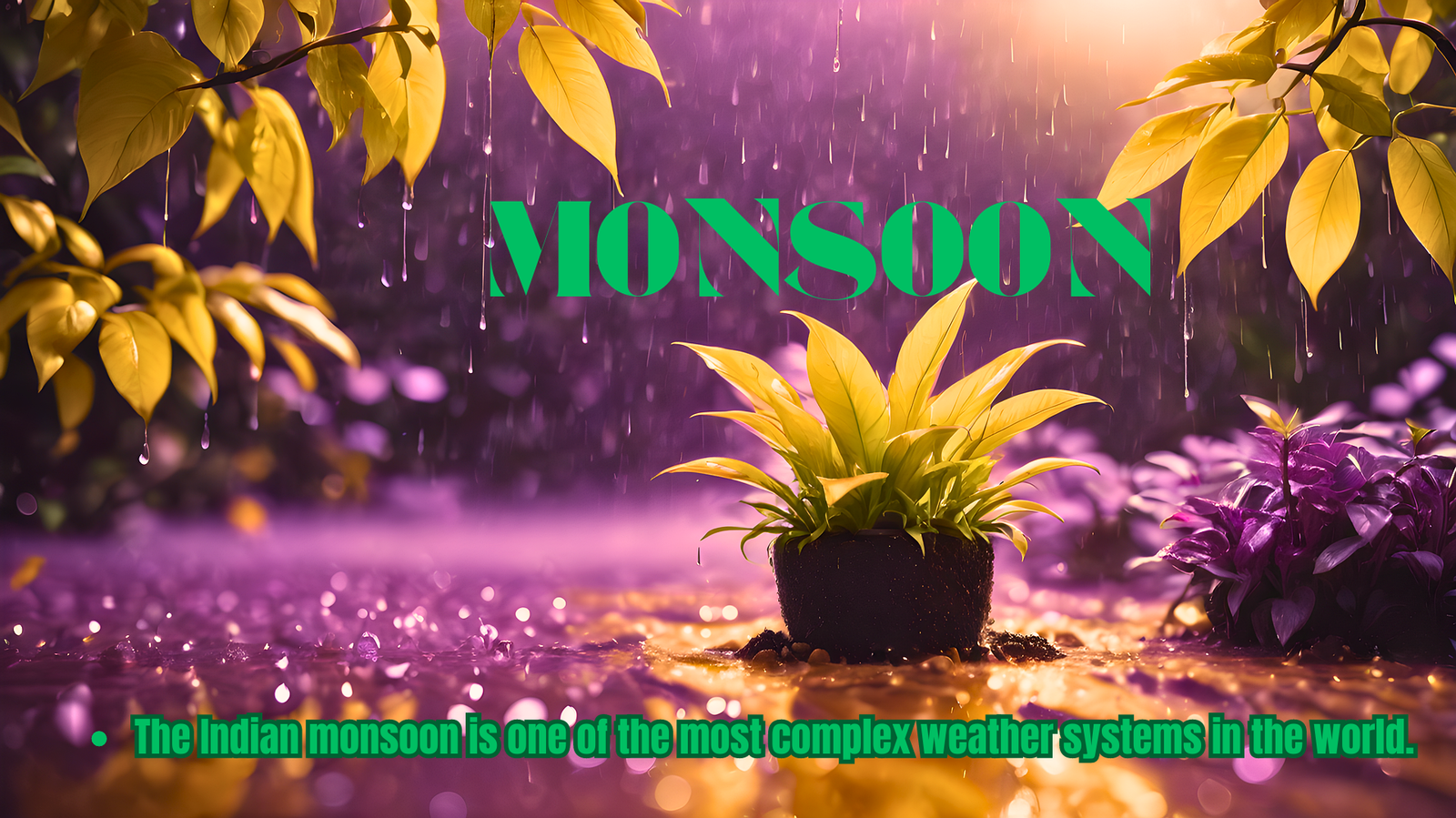Why Do Monsoons Comes in India?
Let’s understand the Indian monsoon. Why, how, when, where and which one?
The Indian monsoon is one of the most complex weather systems in the world, profoundly influencing the subcontinent’s agriculture, economy, and lifestyle. This blog delves into the intricacies of the Indian monsoon, exploring why it occurs, how it functions, when it takes place, where it affects, and which regions experience the most impact.
Why Do Monsoons Come to India?
Monsoons are primarily caused by differential heating of land and water, which creates pressure differences that drive seasonal winds and rainfall patterns.
Differential Heating:- Land heats up and cools down faster than water. During the summer, the Indian subcontinent becomes significantly warmer than the surrounding oceans, particularly the Indian Ocean.
Pressure Systems: –
The intense heat over the landmass creates a low-pressure area, while the relatively cooler Indian Ocean has a high-pressure system. Wind moves from high-pressure to low-pressure areas, drawing moisture-laden winds from the ocean towards the land.
Geographical Position:- The Tropic of Cancer passes through India, placing it in the tropical region where solar heating is intense. This geographical position is crucial for the development of the monsoon system.
Himalayas’ Role:- The Himalayas act as a barrier, preventing the northward movement of moist air masses and causing heavy rainfall in the Indian subcontinent.
How Do Monsoons Function?
Monsoons are driven by the complex interplay of atmospheric and oceanic processes. The primary mechanism can be broken down into several steps:
Formation of Low-Pressure Area:- By late May or early June, the intense heating of the Indian landmass creates a low-pressure area over the Thar Desert and the adjoining areas of the northern Indian subcontinent.
Wind Pattern Change:- The high-pressure area over the Indian Ocean drives moist winds towards the low-pressure area over land. These winds, known as the southwest monsoon winds, travel across the equator and are deflected to the right due to the Coriolis effect, causing them to approach India from the southwest.
Moisture Accumulation and Rainfall:- As these winds travel over the warm waters of the Indian Ocean, they pick up significant moisture. When they encounter the Western Ghats, the Eastern Ghats, and the Himalayas, the air is forced to rise, leading to condensation and heavy rainfall.
Monsoon Trough and Breaks:- The monsoon trough, a low-pressure region extending from the northern plains to the Bay of Bengal, plays a crucial role in the distribution of monsoon rains. There are periods of intense rainfall (active monsoon) and periods of reduced rainfall (break monsoon), influenced by various atmospheric conditions.
When Do Monsoons Occur?
The Indian monsoon season is divided into two distinct phases:
Southwest Monsoon (June to September):- This is the main monsoon season, accounting for about 75% of India’s annual rainfall. The onset usually occurs around the first week of June in Kerala, progressively advancing northwards and covering the entire country by mid-July. The southwest monsoon withdraws from northwestern India by the first week of September, retreating from the Indian subcontinent by early October.
Northeast Monsoon (October to December):- Also known as the retreating monsoon, this phase is significant for the southeastern parts of the country, especially Tamil Nadu. The winds blow from the northeast, bringing rainfall to the eastern coast of India.
Where Do Monsoons Affect?
The Indian monsoon has a wide-ranging impact across the subcontinent, but its effects vary significantly by region:
Western Ghats:- These mountains receive extremely heavy rainfall, especially on the windward side, due to orographic lifting. Places like Mawsynram and Cherrapunji in Meghalaya are among the wettest places on Earth.
Northern Plains:- The Gangetic plains receive substantial rainfall, vital for agriculture. States like Uttar Pradesh, Bihar, and West Bengal benefit greatly from the monsoon rains.
Central India:- Regions such as Madhya Pradesh and Maharashtra receive moderate to heavy rainfall, crucial for crops like soybeans, cotton, and pulses.
Eastern Coast:- Tamil Nadu and parts of Andhra Pradesh receive most of their rainfall during the northeast monsoon. However, they also experience rainfall from the southwest monsoon, although to a lesser extent.
Northeast India:- This region experiences heavy rainfall, with places like Assam and Arunachal Pradesh receiving significant precipitation due to the interaction of moist monsoon winds with the mountainous terrain.
Northwest India:- Rajasthan and Gujarat, being arid and semi-arid regions, receive much less rainfall compared to other parts of India. However, even this limited rainfall is crucial for their agriculture and water resources.
Which Regions Experience the Most Impact?
The impact of the monsoon varies, influencing different sectors in diverse ways:
Agriculture:– The monsoon is the lifeblood of Indian agriculture, which is largely rain-fed. Crops like rice, sugarcane, pulses, and oilseeds depend heavily on monsoon rains. A good monsoon season leads to bumper crops, stabilizing food prices and boosting the economy, whereas a deficient monsoon can lead to droughts, crop failures, and economic instability.
Water Resources:- Monsoon rains are critical for replenishing groundwater levels and filling reservoirs and dams, which are essential for drinking water, irrigation, and hydroelectric power.
Economy:- The agricultural sector, contributing about 15-20% to India’s GDP, is directly influenced by the monsoon. A good monsoon boosts rural income, increasing demand for goods and services, while a poor monsoon can have adverse effects on the economy.
Disaster Management:- Monsoon also brings challenges such as floods, landslides, and waterlogging. Effective disaster management strategies are crucial to mitigate the adverse impacts on life and property.
Health and Environment:- Monsoon season also affects public health, with increased incidents of water-borne diseases like dengue, malaria, and cholera. Additionally, the ecological balance, forest cover, and biodiversity are influenced by the amount and distribution of monsoon rains.
Conclusion
The Indian monsoon is a vital climatic phenomenon, intricately linked with the subcontinent’s ecology, economy, and culture. Understanding why monsoons come to India, how they function, when they occur, where they impact, and which regions experience the most significant effects helps in appreciating their importance. Proper planning, resource management, and disaster preparedness are essential to harness the benefits of the monsoon while mitigating its adverse impacts. The monsoon remains a subject of extensive study and fascination, crucial for sustaining life and livelihoods in India.

Frequently Asked Questions
Monsoons come to India due to differential heating of land and sea, creating pressure differences that drive moisture-laden winds.
Monsoons function by seasonal wind shifts, drawing moist ocean air over land, causing heavy rains due to pressure differences.
Monsoons occur in India from June to September (southwest monsoon) and October to December (northeast monsoon).
Monsoons affect all of India, with heaviest rainfall in Western Ghats, Northeast India, and moderate rainfall in northern and central regions.
The Western Ghats, Northeast India, and northern plains experience the most impact from monsoons, crucial for agriculture and water resources.


